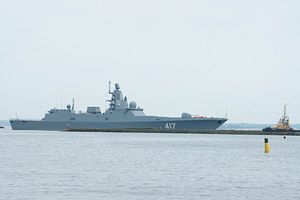The second Admiral Gorshkov-class (Project 22350) guided missile frigate, Admiral Kasatonov, is expected to commence sea trials next summer, according to the November 8 statement issued by the warship’s builder, Severnaya Verf, located on Gutuevsky Island in Saint Petersburg.
The ship, the largest surface warship built by Russia since the collapse of the Soviet Union, will reportedly be handed over to the Russian Navy in February 2018. “The sea trials of the frigate are planned for the beginning of summer,” the shipyard’s press office said.
Meanwhile, the lead ship of the class, the Admiral Gorshkov, was originally expected to be commissioned by the end of November 2017 following multiple delays in one of the Russian Navy’s largest surface warship construction programs. However, Russia’s Ministry of Defense (MoD) has so far not announced a commissioning date.
The Admiral Gorshkov has been under construction for over a decade. As I explained previously (See: “Russia’s Navy to Field 2 New Guided Missile Warships by 2020”):
The Admiral Gorshkov-class program, kicked off in the early 2000s, has faced multiple delays in the last decade. The lead vessel of the class was laid down in 2006, launched in 2010, and has been undergoing builder sea trials since November 2014. It was expected to be handed over to the Russian Navy by November 2016, but technical difficulties with some of the ship’s weapons systems prevented that from happening.
The Admiral Gorshkov’s air defense system in particular contributed to repeated delays. The so-called Polimut Redut air defense missile system has had serious performance and compatibility problems with no indication that the issues have been addressed by now.
The Admiral Gorshkov-class is a multi-purpose platform designed for anti-air, anti-surface, and anti-submarine warfare operations. The ship is armed with the nuclear-capable Kalibr supersonic cruise missile available in land-attack, anti-ship, and anti-submarine variants, and the P-800 Oniks over-the-horizon supersonic anti-ship missile, both of which can be launched from a 16-cell vertical launch system (VLS).
The ship’s engine has also proved to be a headache for Russian shipbuilders. As I pointed out previously:
Russia no longer has access to Ukraine-made gas turbine engines and is in the process of trying to indigenously produce a propulsion system for its large surface warships. Russia may still have enough engines in stock for the first two Admiral Gorshkov-class and three Grigorovich-class vessels. However, it is unclear how quickly Russia’s shipbuilding industry can design a gas turbine of its own.
The Russian defense industry is working on a new propulsion system for surface warfare ships but this will not be ready before 2020. Consequently, it is unclear whether the Admiral Gorshkov-class will move beyond the first two vessels. The Russian Navy reportedly plans to build three additional ships of the class. Two more Admiral Gorshkov-class frigates have been under construction since 2012 and 2013 respectively.
































